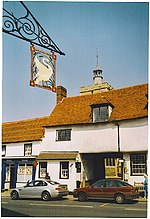Felsted
Civil parishes in EssexFelstedUse British English from February 2018UttlesfordVillages in Essex

Felsted (sometimes spelt Felstead) is a village and civil parish in the Uttlesford district of Essex, England. The civil parish includes the hamlets of Bannister Green, Bartholomew Green, Causeway End, Coblers Green, Cock Green, Frenches Green, Gransmore Green, Hartford End, Molehill Green, Milch Hill, Thistley Green, Watch House Green and Willows Green.
Excerpt from the Wikipedia article Felsted (License: CC BY-SA 3.0, Authors, Images).Felsted
Stebbing Road, Uttlesford Felsted
Geographical coordinates (GPS) Address Nearby Places Show on map
Geographical coordinates (GPS)
| Latitude | Longitude |
|---|---|
| N 51.856 ° | E 0.436 ° |
Address
Felsted Preparatory School
Stebbing Road
CM6 3JD Uttlesford, Felsted
England, United Kingdom
Open on Google Maps








